Abstract
The enzyme linked immunosorbent assay (ELISA) described was developed to detect a soluble antigen in the urine of patients with Legionnaires' disease caused by Legionella pneumophila serogroup 1 (L.pn 1). The assay was evaluated and showed good specificity (100%) and intra-assay reproducibility. Antigen was detected in the urine of 93 (77%) of 120 patients, overall, and in 86% of patients from whom a specimen obtained within seven days of onset of illness was available. On all but one occasion the first urine sample taken from a patient for whom a positive ELISA result was obtained, was itself positive. In one case antigen was not detected at four days but was present on the fifth day after onset of symptoms. In two patients urinary antigen was detectable as early as two days after onset of symptoms. In another the antigen persisted for at least 60 days. More than half the patients, however, had stopped producing detectable antigen within 14 days of onset of symptoms. It is therefore important that where Legionnaires' disease is suspected urine is collected as early as possible in the course of the disease.
Full text
PDF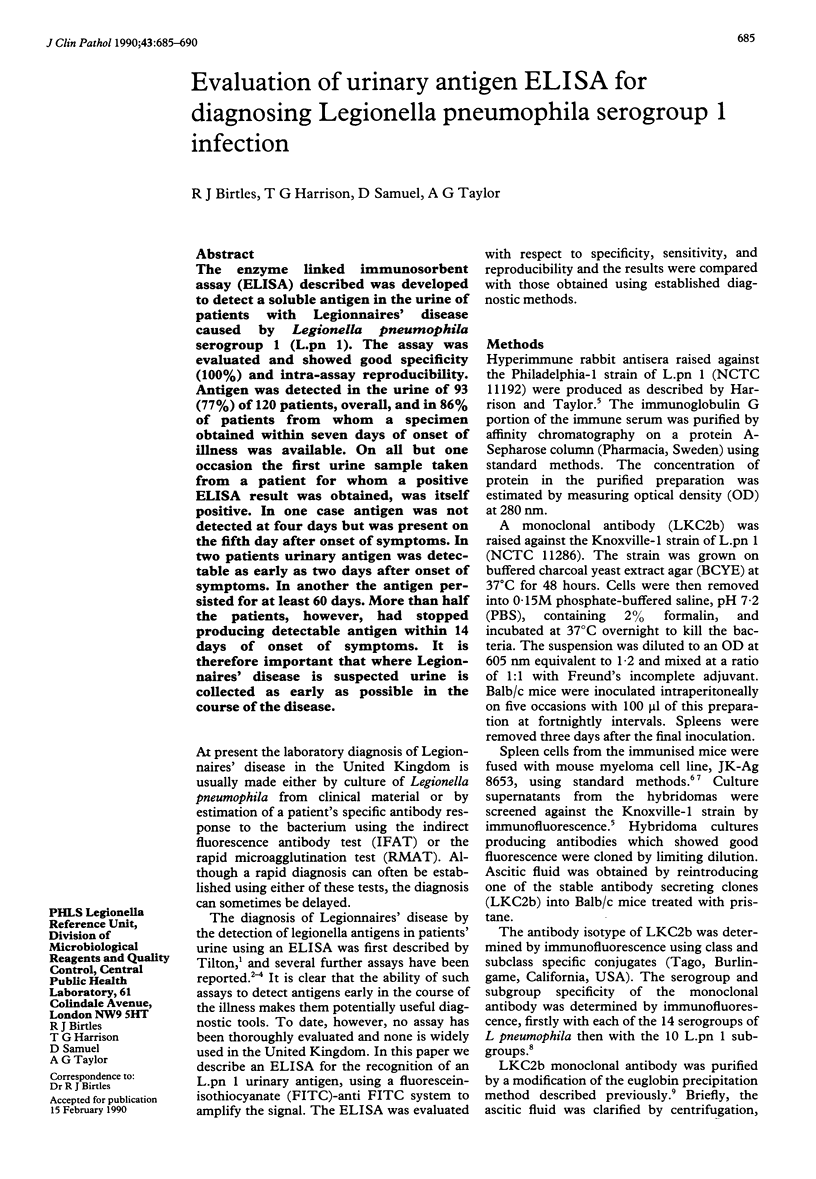

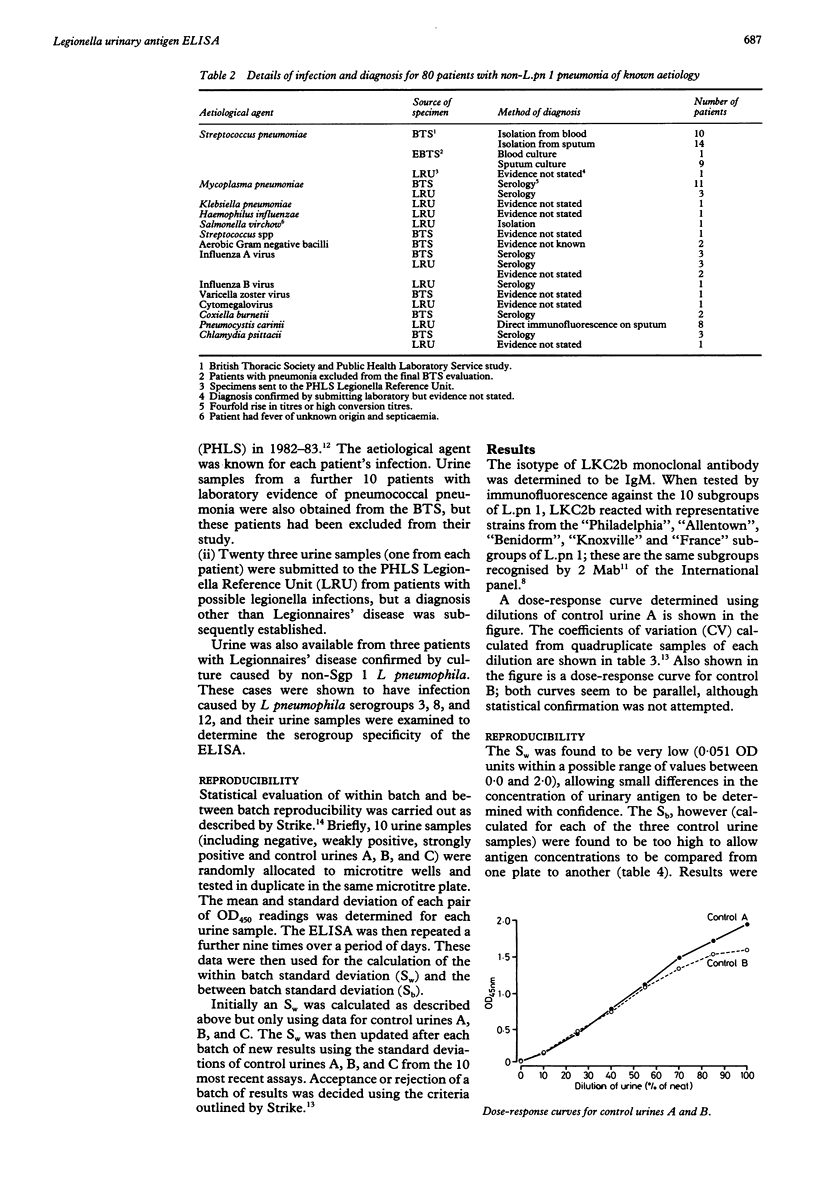
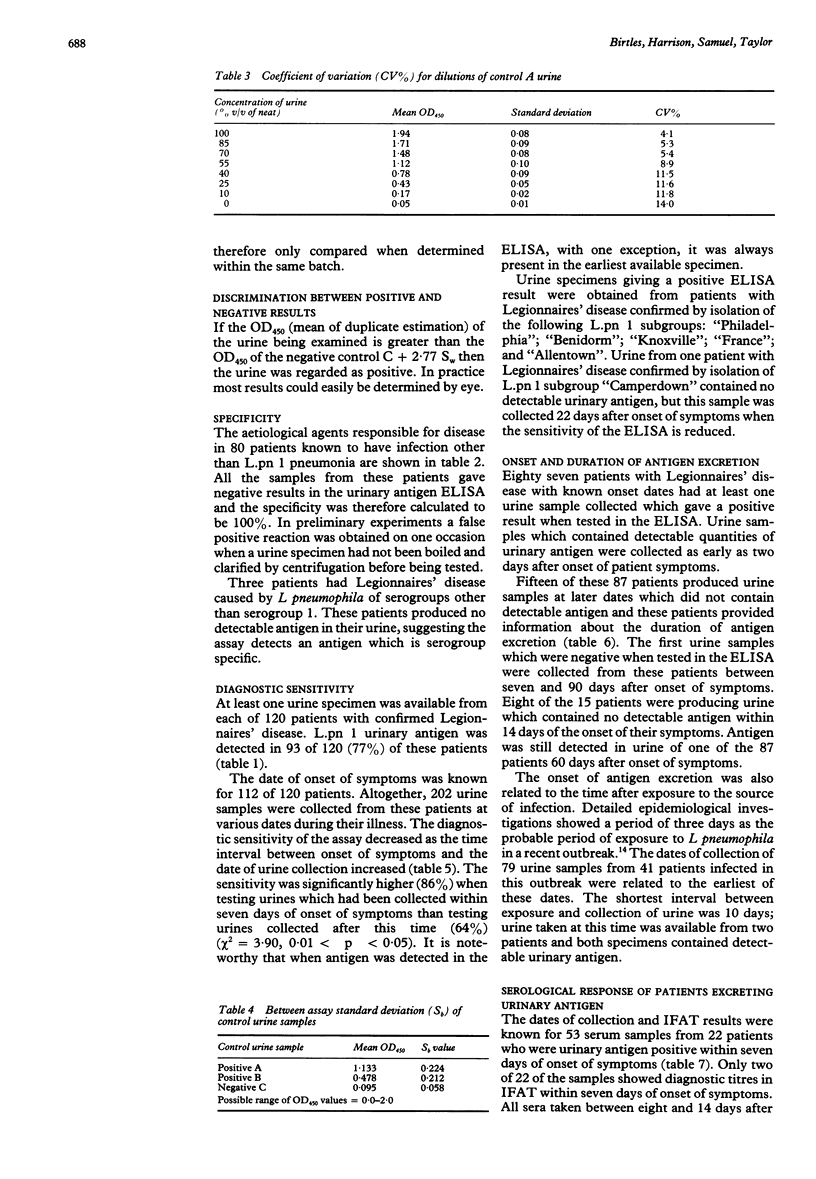
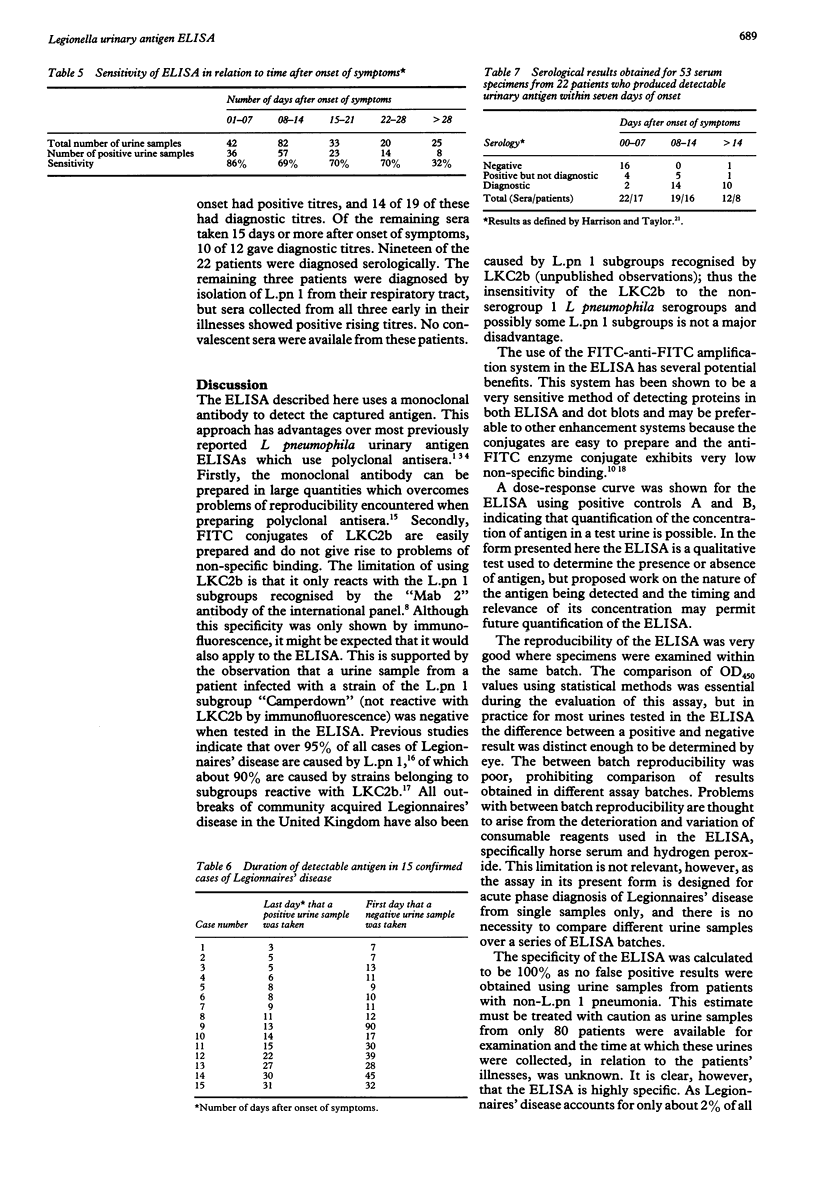
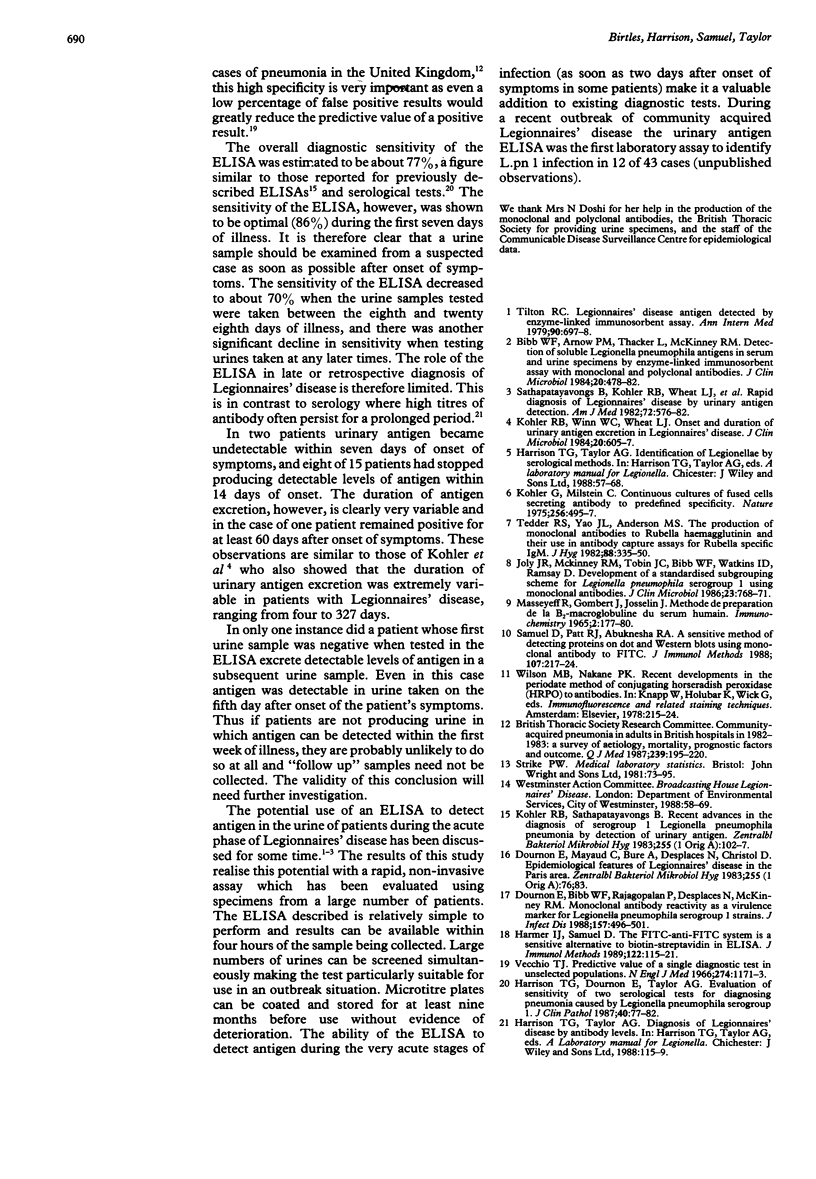
Selected References
These references are in PubMed. This may not be the complete list of references from this article.
- Bibb W. F., Arnow P. M., Thacker L., McKinney R. M. Detection of soluble Legionella pneumophila antigens in serum and urine specimens by enzyme-linked immunosorbent assay with monoclonal and polyclonal antibodies. J Clin Microbiol. 1984 Sep;20(3):478–482. doi: 10.1128/jcm.20.3.478-482.1984. [DOI] [PMC free article] [PubMed] [Google Scholar]
- Dournon E., Bibb W. F., Rajagopalan P., Desplaces N., McKinney R. M. Monoclonal antibody reactivity as a virulence marker for Legionella pneumophila serogroup 1 strains. J Infect Dis. 1988 Mar;157(3):496–501. doi: 10.1093/infdis/157.3.496. [DOI] [PubMed] [Google Scholar]
- Dournon E., Mayaud C., Buré A., Desplaces N., Christol D. Epidemiological features of Legionnaires' disease in the Paris area. Zentralbl Bakteriol Mikrobiol Hyg A. 1983 Jul;255(1):76–83. [PubMed] [Google Scholar]
- Goldsmith R. S., Ingbar S. H. Inorganic phosphate treatment of hypercalcemia of diverse etiologies. N Engl J Med. 1966 Jan 6;274(1):1–7. doi: 10.1056/NEJM196601062740101. [DOI] [PubMed] [Google Scholar]
- Harmer I. J., Samuel D. The FITC-anti-FITC system is a sensitive alternative to biotin-streptavidin in ELISA. J Immunol Methods. 1989 Aug 15;122(1):115–121. doi: 10.1016/0022-1759(89)90341-4. [DOI] [PubMed] [Google Scholar]
- Harrison T. G., Dournon E., Taylor A. G. Evaluation of sensitivity of two serological tests for diagnosing pneumonia caused by Legionella pneumophila serogroup 1. J Clin Pathol. 1987 Jan;40(1):77–82. doi: 10.1136/jcp.40.1.77. [DOI] [PMC free article] [PubMed] [Google Scholar]
- Joly J. R., McKinney R. M., Tobin J. O., Bibb W. F., Watkins I. D., Ramsay D. Development of a standardized subgrouping scheme for Legionella pneumophila serogroup 1 using monoclonal antibodies. J Clin Microbiol. 1986 Apr;23(4):768–771. doi: 10.1128/jcm.23.4.768-771.1986. [DOI] [PMC free article] [PubMed] [Google Scholar]
- Kohler R. B., Sathapatayavongs B. Recent advances in the diagnosis of serogroup 1 L. pneumophila pneumonia by detection of urinary antigen. Zentralbl Bakteriol Mikrobiol Hyg A. 1983 Jul;255(1):102–107. [PubMed] [Google Scholar]
- Kohler R. B., Winn W. C., Jr, Wheat L. J. Onset and duration of urinary antigen excretion in Legionnaires disease. J Clin Microbiol. 1984 Oct;20(4):605–607. doi: 10.1128/jcm.20.4.605-607.1984. [DOI] [PMC free article] [PubMed] [Google Scholar]
- Köhler G., Milstein C. Continuous cultures of fused cells secreting antibody of predefined specificity. Nature. 1975 Aug 7;256(5517):495–497. doi: 10.1038/256495a0. [DOI] [PubMed] [Google Scholar]
- Masseyeff R., Gombert J., Josselin J. Methode de preparation de la beta-2-macroglobuline du serum humain. Immunochemistry. 1965 Jun;2(2):177–180. doi: 10.1016/0019-2791(65)90019-4. [DOI] [PubMed] [Google Scholar]
- Samuel D., Patt R. J., Abuknesha R. A. A sensitive method of detecting proteins on dot and Western blots using a monoclonal antibody to FITC. J Immunol Methods. 1988 Mar 16;107(2):217–224. doi: 10.1016/0022-1759(88)90221-9. [DOI] [PubMed] [Google Scholar]
- Sathapatayavongs B., Kohler R. B., Wheat L. J., White A., Winn W. C., Jr, Girod J. C., Edelstein P. H. Rapid diagnosis of Legionnaires' disease by urinary antigen detection. Comparison of ELISA and radioimmunoassay. Am J Med. 1982 Apr;72(4):576–582. doi: 10.1016/0002-9343(82)90451-x. [DOI] [PubMed] [Google Scholar]
- Tedder R. S., Yao J. L., Anderson M. J. The production of monoclonal antibodies to rubella haemagglutinin and their use in antibody-capture assays for rubella-specific IgM. J Hyg (Lond) 1982 Apr;88(2):335–350. doi: 10.1017/s0022172400070182. [DOI] [PMC free article] [PubMed] [Google Scholar]
- Tilton R. C. Legionnaires' disease antigen detected by enzyme-linked immunosorbent assay. Ann Intern Med. 1979 Apr;90(4):697–698. doi: 10.7326/0003-4819-90-4-697. [DOI] [PubMed] [Google Scholar]


